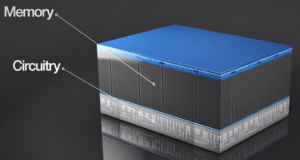
Micron Stacks Higher to Boost 3D NAND Flash

Source: Micron Technology
The high-density 3D NAND flash memory unveiled by Micron Technology this week promises to boost storage application performance from the data center to the edge, potentially hastening the enterprise shift to all-flash storage.
The memory chip maker (NASDAQ: MU) said it has begun volume shipments of its 176-layer 3D NAND flash memory that is claimed to boost read and write densities by more than 35 percent. Those and other performance enhancements are attributed to 3D replacement-gate architecture that uses a non-conductive layer of silicon nitride acting as a NAND storage cell to trap electrical charges.
The result is more storage cells and a doubling of read, write and erase times in SSDs.
Micron said Monday (Nov. 9) it is targeting its next generation NAND flash technology at emerging AI, 5G, cloud, edge and other data-intensive workloads as in-memory computing and storage resources move closer to where data is generated.
The stacked replacement-gate architecture, which departs from traditional floating-gate approaches, crams 176 layers into same space as previous 64, thereby reducing die size by 30 percent, the company said.
The approach could aid in “accelerating the transition to all-flash storage,” according to Derek Dicker, general manager of Micron’s Storage Business Unit.
Micron attributes the storage density gains to its CMOS-under-array stacking architecture, which company executives likened to transforming a surface parking lot to an unground parking garage. The approach, which constructs a multi-layered stack over the chip’s logic, yielded a 30 percent reduction in die size. That allowed the stacking of more layers in the same space.
The 176-layer device is billed as nearly 10 times denser than previous generations of NAND flash chips. Hence, Micron is promoting its fifth-generation 3D NAND and second-generation replacement-gate memory as a building block for cloud storage. The flash memory is also being positioned as providing sufficient storage density to help operators meet stringent quality-of-service requirements for data center SSDs.
Micron further claimed its flash device delivers a 33-percent performance boost for maximum data rate transfers.
The company is currently shipping the 176-layer NAND in volume via its “crucial consumer SSD” product line while working with “industry developers” to integrate its latest 3D NAND technology.
Dicker declined to identify data center or other enterprise customers.
The memory maker said it expects to introduce new products based on the 176-layer NAND design beginning next year. (The layer figure refers to the number of storage cell levels.)
Along with all-flash deployments in data centers, Micron is also promoting the new flash memory design for AI inference and high-speed edge computing use cases. It further claimed the replacement-gate approach boosts mixed workloads for those and other edge applications by as much as 15 percent.
Dicker deferred specific questions about technical performance to an upcoming company webinar.
The memory maker did note in a white paper released this week that its replacement-gate approach removed limitations on stack height for individual devices, thereby boosting storage capacity. Further, write performance and power efficiency were increased while algorithm complexity was reduced.
The chip design is also promoted as increasing the overall endurance of NAND flash devices.



























